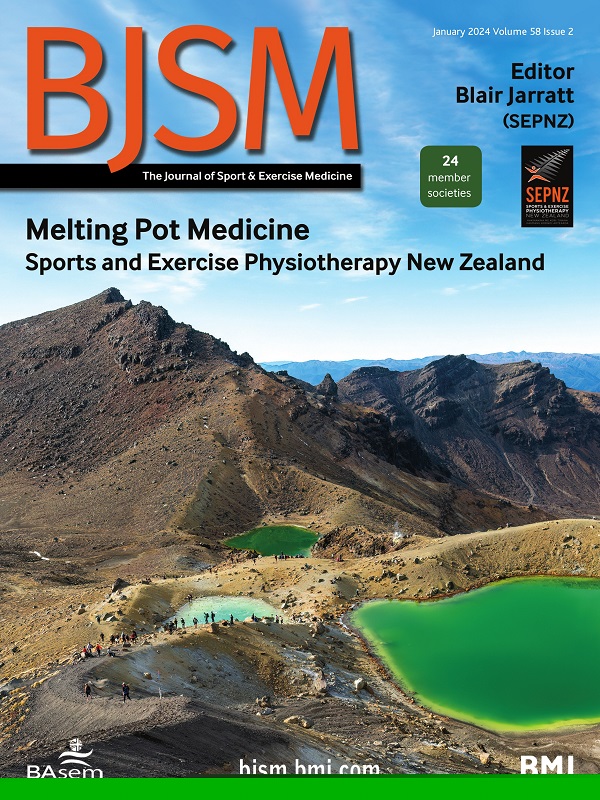A framework for safe, healthy and sustainable participation in elite Para sport
IF 16.2
1区 医学
Q1 SPORT SCIENCES
引用次数: 0
Abstract
Para athletes report relatively high rates of sports injuries and illnesses compared with non-disabled athletes as well as other health problems related to impairments, overuse injuries in daily life and mental distress.1 2 Additionally, many Para athletes at elite level need to navigate common life stressors such as maintaining a work-life balance, transitioning careers, financial uncertainty and parenthood. Despite all these challenges, most preventive frameworks, return to play protocols, pre-participation programmes and athlete health consensus guidelines in sports remain unsuitable to the unique needs of Para athletes. Moreover, the knowledge about Para athletes’ health is scarce within the sports and exercise community, and many athletes do not have the same support structures as non-disabled athletes.3 Para athletes live with an impairment as a result of a confirmed medical diagnosis and are often at risk of secondary health conditions that could have an impact both on their daily activities and participation in sport. Therefore, there is a pressing need to enhance their well-being at both primary, secondary and tertiary health levels. Additionally, Haddon’s injury prevention matrix suggests that most health incidents are a sequence of events representing a continuum of different factors related to the individual, the physical and social environment.4 Hence, we need to think broadly when it comes to injury and illness prevention in Para sport. Recently, it has been suggested that health promotion is an appropriate tool for injury and illness prevention within the Para sports context due to its broad reach and engagement.5 To effectively facilitate the development, communication and …一个安全、健康和可持续参与精英残疾人运动的框架
与非残疾运动员相比,残疾人运动员报告的运动损伤和疾病发生率相对较高,以及与日常生活中的损伤、过度使用损伤和精神困扰相关的其他健康问题。此外,许多精英水平的残疾人运动员需要应对常见的生活压力,如保持工作与生活的平衡、职业转型、经济不确定性和为人父母。尽管存在所有这些挑战,但大多数预防框架、恢复比赛协议、参加前规划和运动员健康共识准则仍然不适合残疾人运动员的独特需求。此外,在体育和运动社区中,关于残疾人运动员健康的知识很少,许多运动员没有与非残疾运动员相同的支持结构残疾运动员由于确诊的医疗诊断而存在残疾,并且往往面临可能影响其日常活动和参加体育运动的继发性健康状况的风险。因此,迫切需要在初级、二级和三级健康水平上提高他们的福祉。此外,Haddon的伤害预防矩阵表明,大多数健康事件是一系列事件,代表了与个人、身体和社会环境相关的不同因素的连续体因此,当涉及到残疾人运动的伤害和疾病预防时,我们需要广泛地思考。最近,有人建议,健康促进是一种适当的工具,以伤害和疾病预防在残疾人体育背景下,由于其广泛的覆盖面和参与有效地促进发展、沟通和…
本文章由计算机程序翻译,如有差异,请以英文原文为准。
求助全文
约1分钟内获得全文
求助全文
来源期刊
CiteScore
27.10
自引率
4.90%
发文量
217
审稿时长
3-8 weeks
期刊介绍:
The British Journal of Sports Medicine (BJSM) is a dynamic platform that presents groundbreaking research, thought-provoking reviews, and meaningful discussions on sport and exercise medicine. Our focus encompasses various clinically-relevant aspects such as physiotherapy, physical therapy, and rehabilitation. With an aim to foster innovation, education, and knowledge translation, we strive to bridge the gap between research and practical implementation in the field. Our multi-media approach, including web, print, video, and audio resources, along with our active presence on social media, connects a global community of healthcare professionals dedicated to treating active individuals.

 求助内容:
求助内容: 应助结果提醒方式:
应助结果提醒方式:


